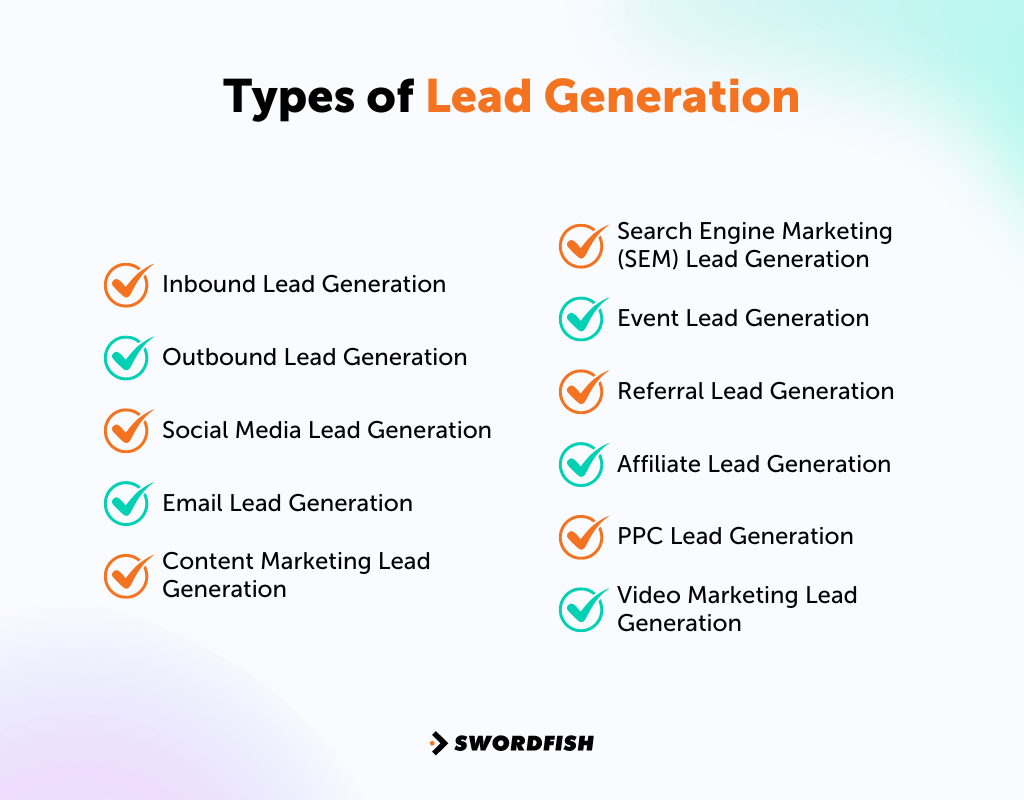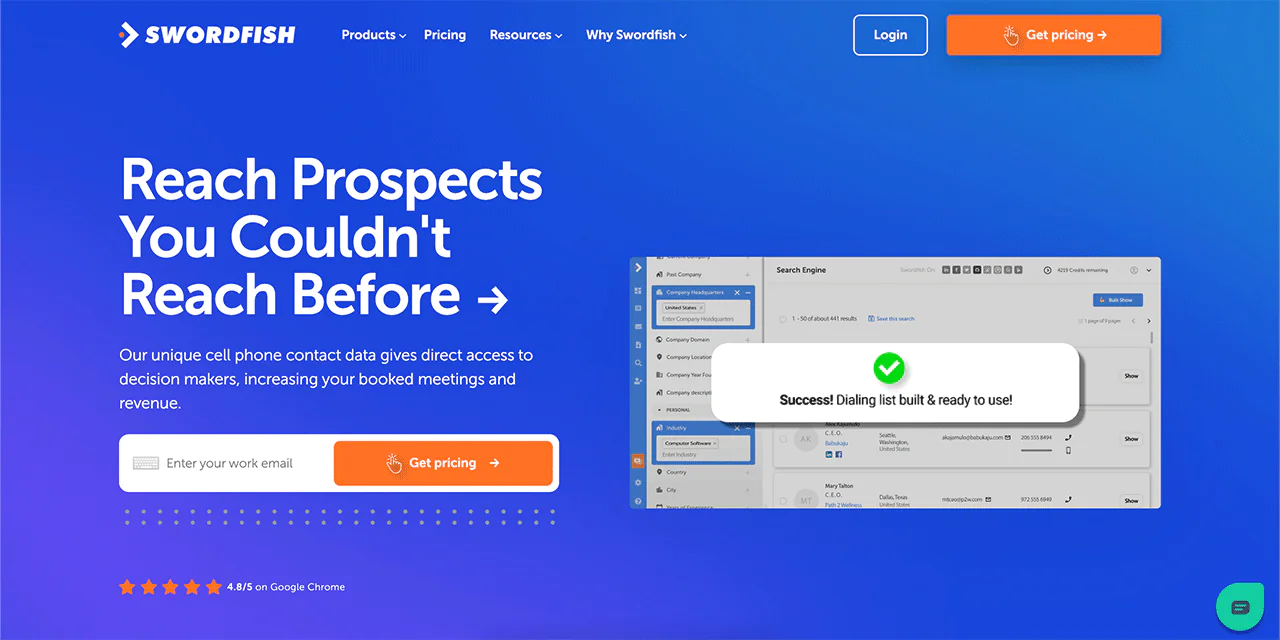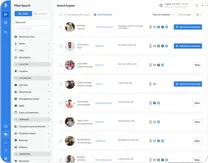
Ever wondered what’s actually driving the change in sales lead generation this year? The answer lies in the power of connection.
Nowadays, successful businesses prioritize meaningful interactions over transactional encounters. So, by using new tools and tactics, companies are finding innovative ways to engage with potential clients. This ensures that every lead is not just a number, but a relationship in the making.
Join us as in this guide, we’ll look into the innovative realm of sales lead generation, where connecting with potential customers has become an art form. It surely promises to redefine the future of sales. Let’s buckle up!
What is Sales Lead Generation?
First of all, you need to know about lead generation. Sales lead generation is a critical initial phase in the sales funnel where businesses focus on attracting and engaging individuals. It could be prospective buyers as well.
This foundational step is about more than just identifying possible customers, though. It’s about sparking an interest in what you’re selling and fostering that interest to the point where a lead is ready to consider a purchase.
Well, let’s confirm that it’s no longer just about casting a wide net and hoping for the best. Modern strategies are data-driven and finely tuned to target specific demographics.

For example, businesses might use targeted content marketing. So, according to HubSpot, it generates three times as many leads as traditional outbound marketing but costs 62% less.
Moreover, effective lead generation now encompasses a blend of inbound and outbound marketing tactics. Inbound methods draw customers in with valuable content and engaging social media presence. On the other hand, outbound tactics might include more direct approaches like email campaigns and pay-per-click advertising.
Therefore, the goal here is to create a digital ecosystem that nurtures potential leads at every touchpoint. With 63 percent of consumers needing to hear company claims 3-5 times before they believe them, as reported by Edelman Trust Barometer, consistent and strategic engagement becomes crucial.
Types of Lead Generation
Sales lead generation can be categorized into several types based on the techniques and channels used to attract and engage potential customers. Here are some of the primary lead generation examples:

Inbound Lead Generation
This type involves attracting leads through content creation, SEO, social media, and other strategies that make it easy for potential customers to find you.
Outbound Lead Generation
This traditional form of lead generation includes reaching out to potential customers through cold calling, direct mail, email blasts, and other methods where the marketer initiates the first contact.
Social Media Lead Generation
Utilizing platforms like LinkedIn, Twitter, Facebook, and Instagram, businesses can engage with potential leads by sharing content, participating in discussions, and running targeted ads.
Email Lead Generation
By sending personalized emails to a curated list of potential leads, businesses can nurture relationships and guide prospects through the sales funnel.
Content Marketing Lead Generation
Offering valuable content like blogs, ebooks, whitepapers, and webinars can attract leads by establishing your brand as a thought leader.
Search Engine Marketing (SEM) Lead Generation
This involves using paid advertising on search engines to drive traffic to your website, where visitors can be converted into leads.
Event Lead Generation
Attending, hosting, or participating in events like webinars, conferences, and trade shows can help in collecting leads through networking and presentations.
Referral Lead Generation
Encouraging existing customers to refer new leads to your business can be a highly effective way to generate sales leads
Affiliate Lead Generation
Partner with other businesses or individuals who can promote your products to their audience in exchange for a commission for each lead or sale.
PPC Lead Generation
Pay-per-click campaigns on platforms like Google AdWords or Bing Ads can drive targeted traffic to landing pages designed to convert visitors into leads.
Video Marketing Lead Generation
Creating engaging video content can attract leads by providing a dynamic way to present information, showcase products, and tell your brand’s story.
Importance of Sales Lead Generation
The vitality of sales lead generation in the business ecosystem is multi-dimensional. Here’s a detailed breakdown of its importance:

Fuels the Sales Pipeline
At its core, sales lead generation is the lifeblood of the sales pipeline. It’s about creating a flow of potential customers who are interested in what you’re selling.
Without a consistent influx of leads, the pipeline dries up, and sales teams have nothing to work with. It’s the difference between a thriving business and one that’s struggling to make ends meet.
Drives Business Growth
Leads are potential sales, and sales are the engine of growth for any business. A robust lead generation strategy directly correlates with increased revenue.
According to most statistics, lead generation companies with strong lead generation practices achieved more revenue than those with poor practices.
Enhances Market Presence
Generating leads isn’t just about immediate sales; it’s also about market presence. The more people you have interested in your product, the more your brand is talked about.
This buzz can elevate your brand’s position in the market, making it more recognizable and trusted.
Improves Product Fit
Through lead generation, you gather invaluable data about what your potential customers are looking for. This feedback loop can inform product development, ensuring your offer aligns with market demands.
Boosts Conversion Rates
A strategic lead generation process targets individuals who are more likely to convert into customers. By focusing on the quality of leads rather than just quantity, businesses can improve their conversion rates.
According to research, the average lead conversion rate across industries is around 2.35%, but with targeted lead generation, top companies report a conversion rate of up to 11.45%.
Ensures Competitive Advantage
Well, having a steady stream of leads can be the edge a company needs. It allows businesses to stay ahead, not just by reaching potential customers first but by continuously engaging and re-engaging them.
This persistent engagement is key in a world where, according to Salesforce, it takes 6-8 touches to generate a viable sales lead.

Optimizes Marketing ROI
Effective lead generation strategies mean that marketing efforts are not wasted on uninterested parties.
Thus, by targeting those who have shown interest or fit the buyer persona, companies can get a better return on investment (ROI) for their marketing spend. Data suggests that lead generation can improve the ROI of marketing campaigns by up to 72%.

Facilitates Strategic Planning
Last but not least, with a steady flow of leads, businesses can forecast and plan more effectively.
Hence, they can anticipate sales volumes, manage inventory better, and allocate resources more efficiently. This strategic planning is crucial for long-term stability and growth.
How Does Lead Generation Work?
Lead generation is a crucial process for businesses, especially in the B2B sector, but also in B2C markets. It involves identifying and cultivating potential customers for a business’s products or services.
Here’s a breakdown of how lead generation works:
Identifying the Target Audience: The process begins with determining who the potential customers are, based on market research and analysis.
Creating Engaging Content: Businesses develop content that is relevant and appealing to their target audience. This content is designed to attract potential leads.
Using Lead Magnets: Lead magnets, such as free trials, ebooks, or webinars, are offered to entice potential customers to provide their contact information.
Landing Pages and Forms: These are designed to capture lead information. When a visitor fills out a form, they become a lead.
Promotion and Advertising: The content and lead magnets are promoted through various channels like social media, email marketing, or paid advertising to reach a wider audience.
Lead Scoring and Qualification: Leads are evaluated based on their likelihood to purchase. This process helps in prioritizing leads that are more likely to convert into customers.
Nurturing Leads: Through email campaigns, follow-up calls, and personalized content, businesses nurture their leads to move them further down the sales funnel.
Conversion: The ultimate goal is to convert these leads into paying customers by persuading them to purchase a product or service.
Analysis and Optimization: Regular analysis of the lead generation process is conducted to identify areas for improvement and to optimize strategies for better results.
Feedback and Relationship Building: Post-conversion, maintaining relationships and gathering feedback is crucial for future opportunities and referrals.
Pros and Cons of Sales Lead Generation
Below there are the pros and cons of sales lead generation:
Pros
- This amplifies brand visibility and establishes market presence.
- Builds a solid pipeline for sustained sales growth.
- Enables precise targeting to reach ideal customers efficiently.
- It fosters early engagement that sets the stage for customer loyalty.
- Collects valuable data for refining marketing and sales strategies.
Cons
- It can be resource-heavy, demanding significant investment of time and capital.
- It does not guarantee conversion, potentially leading to lower ROI.
11 Ways to Supercharge Sales Lead Generation in 2023
As we step into 2023, let’s explore 11 cutting-edge techniques that can turbocharge your sales lead generation. This ensures your funnel is brimming with high-quality prospects.

Here’s how you can revamp your approach and set the stage for a record-breaking year in sales:
Integrate Advanced AI Analytics
Well, these days, utilizing the power of artificial intelligence and machine learning is not just an option but a necessity. Businesses can sift through vast amounts of data to discern patterns and predict future buying behaviors by implementing AI-driven tools.
This allows for the crafting of highly targeted lead generation campaigns that are more likely to resonate with potential customers and result in successful conversions.
Deepen Personalization Tactics
Personalization has evolved far beyond the mere inclusion of a recipient’s name in an email. Today, using detailed behavioral data to customize every interaction is key.
This means analyzing past interactions, purchase history, and engagement levels to create messages that speak directly to individual preferences. It also significantly enhances the chances of engagement.
Voice Search Optimization
With the proliferation of virtual assistants and smart speakers, optimizing for search is important. This involves understanding the more conversational tone and longer phrases used in voice queries and ensuring your content answers those queries directly.
Thus, it’s about being where your customers are and increasingly, they’re speaking to devices, not just typing on keyboards.
Embrace Video Marketing
Video content has a proven track record of high engagement rates. By producing videos that inform and entertain, businesses can tap into the shareable nature of such content.
This also increases visibility and lead generation potential. Videos can be used to demonstrate products, explain lead generation services, or simply tell the brand’s story, all of which can foster a stronger connection with potential leads. Even short video presentations within emails or on social media can be powerful tools to capture attention and introduce viewers to your brand or product.
Interactive Tools for Engagement
Interactive tools like quizzes, calculators, and demos invite potential leads to engage with your brand in a meaningful way.
These tools can not only capture lead information but also increase the likelihood of a lead moving further down the sales funnel by providing immediate value
Commit to Quality Content Creation
Content is often the first point of contact between your brand and potential leads. By committing to producing high-quality, informative content, you establish your brand as a credible authority in your field.
This content should not only inform but also engage and inspire readers to see your brand as a trusted resource, thereby nurturing them until they are ready to make a purchase.
Evolve SEO Strategies
Search engine optimization is an ever-changing landscape, and staying ahead of the curve is essential. This means regularly updating your strategies to align with the latest algorithm changes and user behavior trends.
A strong SEO strategy ensures that your content is visible and ranks well in search results, drawing in organic traffic that could convert into qualified leads.
Dynamic Social Media Engagement
Social media is a dynamic platform for lead generation. In 2023, it’s about more than just posting regularly, it’s about fostering genuine interactions.
By engaging with users, sharing content that adds real value, and utilizing targeted advertising, businesses can create a community around their brand. They can also turn that community into a consistent source of new leads.
Using Influencer Partnerships
Collaborating with influencers in your industry can significantly boost your lead-generation efforts. Influencers often have a dedicated and engaged audience.
So, by partnering with them, you can tap into their follower base, increasing your brand’s visibility and credibility.
Hosting and Participating in Industry Events
Hosting webinars, and workshops, or participating in industry conferences and trade shows can be a powerful way to generate leads.
These events provide an opportunity to showcase your expertise, network with potential clients, and collect contact information from attendees interested in your products or services.
Utilizing Referral Programs
Implementing a customer referral program can be an effective way to generate new leads. Encouraging your existing customers to refer friends or colleagues in exchange for rewards or discounts can lead to a steady stream of qualified leads.
This method leverages the trust and satisfaction of your current customer base to expand your reach.
How to Improve Lead Generation

How to Use A/B Testing to Improve Lead Generation
A/B testing, also known as split testing, is a method of comparing two versions of a web page or app against each other to determine which one performs better. It’s a powerful tool for improving lead generation.
Here’s how to use A/B testing effectively for lead generation:
Define Clear Objectives
Begin by setting specific goals for your A/B test. This could involve increasing conversion rates, enhancing click-through rates, or boosting the number of form submissions.
Having clear, measurable objectives allows you to focus your testing and accurately measure success.
Select the Element to Test
Identify a key element on your webpage or in your marketing material that you believe influences user behavior. This could be anything from the text of a call-to-action button, the color of a sign-up form, the layout of a landing page, to the images used.
The element should be significant enough to potentially impact lead generation.
Create Two Variants
Develop two versions: the original version (control) and a modified version (variant). The variant should only differ in the one element you’re testing to isolate the impact of that specific change.
For instance, if you’re testing a headline, change only the text of the headline and keep everything else the same.
Segment Your Audience
Divide your audience into two or more groups randomly. Each group should be exposed to only one version of the element. This segmentation is crucial to ensure that the results are not influenced by variables other than the element being tested.
Implement the Test
Use A/B testing tools to serve the different versions to your segmented audience. Tools like Google Optimize, Optimizely, or VWO can help automate this process.
Make sure the test runs for a sufficient duration to collect a robust set of data, but be mindful of external factors like seasonality or market trends that might skew the results.
Analyze the Results
After the test period, analyze the data collected. Look at how each version performed against your objectives. Use statistical methods to determine if the differences in performance are significant and not just due to chance.
Draw Conclusions and Implement Changes
Based on the analysis, decide which version (control or variant) is more effective in achieving your lead generation goals. Implement the winning version.
If the results are inconclusive, consider refining your test and trying again.
Monitor Post-Implementation Performance
After implementing the successful element, continue to monitor its performance. Sometimes, what works in a test environment might behave differently in the real world.
Ongoing monitoring ensures that the changes positively impact your lead-generation efforts in the long term.
Iterate and Optimize
A/B testing is not a one-time activity. Use the insights gained from each test to continuously refine and optimize your lead generation strategies.
Also, regular testing can lead to incremental improvements that significantly boost overall performance over time.
Use Swordfish AI for Sales Lead Generation

Swordfish AI stands out in sales lead generation with its exceptional data collection accuracy and depth. It adeptly mines vast web and database resources, securing a large volume of high-quality leads that boosts sales conversion potential.
Its seamless CRM system integration streamlines the sales process, allowing teams to focus on engaging and closing leads effectively. The tool’s detailed data insights enable personalized outreach. It enhances engagement and increases conversion rates.
Moreover, Swordfish AI provides unique insights for smarter prospect engagement, giving users a competitive advantage. This efficient tool not only speeds up the sales cycle but also scales with your business growth.
How Swordfish AI Helps in Collecting Leads
Extensive Web and Database Mining: Swordfish AI utilizes advanced algorithms to scour through vast web and database resources. This also identifies potential leads with precision.
Integration with CRM Systems: It smoothly integrates with existing CRM platforms. This confirms that the lead generation process is streamlined and efficient.
Rich Data Insights for Personalization: The tool provides in-depth data insights, that enable teams to craft highly personalized outreach strategies that resonate with potential leads.
Strategic Engagement with Prospects: With unique data insights, Swordfish AI empowers sales teams to engage with prospects in a more strategic and informed manner.
Time and Cost Efficiency: It offers a time-saving and cost-effective approach to lead generation, accelerating the sales cycle and supporting business scalability.
Compliance and Reliability: Swordfish AI is committed to compliance. It makes sure that the data used for lead generation is both reliable and responsibly managed.
Elevate your lead generation game with Swordfish AI. Click here to start your free trial and unlock targeted sales opportunities.
Conclusion
Indeed, the blend of advanced technology and personal interaction is transforming the landscape of sales lead generation. Adopting these 11 innovative approaches positions companies to not only increase their number of leads but also to enhance the quality of potential customers they attract.
This methodical approach is designed to improve conversion rates, strengthen financial stability, and secure a competitive advantage. The goal is to develop a lead generation environment that not only grabs attention but also builds enduring customer loyalty.
In the mix of using data and talking to people, businesses that get really good at finding new leads with the latest methods are set to do well in the fast-changing world of business. Good luck out there!
FAQs
What is the difference between a lead and a prospect?
A lead has shown interest in your company’s product or service. At the same time, a prospect is a qualified lead determined to fit your target market criteria and is more likely to become a customer. Essentially, all prospects are leads, but not all leads become prospects.
Is social media effective for lead generation?
Yes, social media can be highly effective for lead generation. It allows you to engage with potential customers directly and build relationships. By sharing valuable content, responding to queries, and running targeted ads, you can generate leads that are interested in your products or services.
How do you track the ROI of lead generation activities?
Tracking ROI involves measuring the costs of your lead generation activities against the revenue generated from converted leads. This can be done by assigning tracking codes to your marketing materials, setting up conversion tracking in your analytics software, and monitoring the sales pipeline.


 View Products
View Products



